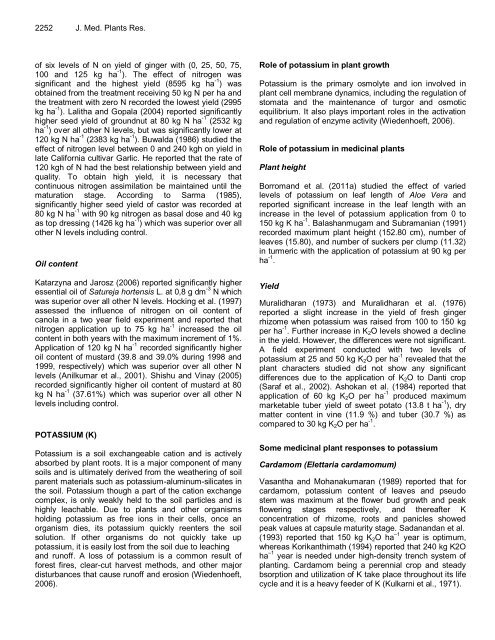Download Complete Issue - Academic Journals
Download Complete Issue - Academic Journals
Download Complete Issue - Academic Journals
Create successful ePaper yourself
Turn your PDF publications into a flip-book with our unique Google optimized e-Paper software.
2252 J. Med. Plants Res.<br />
of six levels of N on yield of ginger with (0, 25, 50, 75,<br />
100 and 125 kg ha -1 ). The effect of nitrogen was<br />
significant and the highest yield (8595 kg ha -1 ) was<br />
obtained from the treatment receiving 50 kg N per ha and<br />
the treatment with zero N recorded the lowest yield (2995<br />
kg ha -1 ). Lalitha and Gopala (2004) reported significantly<br />
higher seed yield of groundnut at 80 kg N ha -1 (2532 kg<br />
ha -1 ) over all other N levels, but was significantly lower at<br />
120 kg N ha -1 (2383 kg ha -1 ). Buwalda (1986) studied the<br />
effect of nitrogen level between 0 and 240 kgh on yield in<br />
late California cultivar Garlic. He reported that the rate of<br />
120 kgh of N had the best relationship between yield and<br />
quality. To obtain high yield, it is necessary that<br />
continuous nitrogen assimilation be maintained until the<br />
maturation stage. According to Sarma (1985),<br />
significantly higher seed yield of castor was recorded at<br />
80 kg N ha -1 with 90 kg nitrogen as basal dose and 40 kg<br />
as top dressing (1426 kg ha -1 ) which was superior over all<br />
other N levels including control.<br />
Oil content<br />
Katarzyna and Jarosz (2006) reported significantly higher<br />
essential oil of Satureja hortensis L. at 0,8 g dm -3 N which<br />
was superior over all other N levels. Hocking et al. (1997)<br />
assessed the influence of nitrogen on oil content of<br />
canola in a two year field experiment and reported that<br />
nitrogen application up to 75 kg ha -1 increased the oil<br />
content in both years with the maximum increment of 1%.<br />
Application of 120 kg N ha -1 recorded significantly higher<br />
oil content of mustard (39.8 and 39.0% during 1998 and<br />
1999, respectively) which was superior over all other N<br />
levels (Anilkumar et al., 2001). Shishu and Vinay (2005)<br />
recorded significantly higher oil content of mustard at 80<br />
kg N ha -1 (37.61%) which was superior over all other N<br />
levels including control.<br />
POTASSIUM (K)<br />
Potassium is a soil exchangeable cation and is actively<br />
absorbed by plant roots. It is a major component of many<br />
soils and is ultimately derived from the weathering of soil<br />
parent materials such as potassium-aluminum-silicates in<br />
the soil. Potassium though a part of the cation exchange<br />
complex, is only weakly held to the soil particles and is<br />
highly leachable. Due to plants and other organisms<br />
holding potassium as free ions in their cells, once an<br />
organism dies, its potassium quickly reenters the soil<br />
solution. If other organisms do not quickly take up<br />
potassium, it is easily lost from the soil due to leaching<br />
and runoff. A loss of potassium is a common result of<br />
forest fires, clear-cut harvest methods, and other major<br />
disturbances that cause runoff and erosion (Wiedenhoeft,<br />
2006).<br />
Role of potassium in plant growth<br />
Potassium is the primary osmolyte and ion involved in<br />
plant cell membrane dynamics, including the regulation of<br />
stomata and the maintenance of turgor and osmotic<br />
equilibrium. It also plays important roles in the activation<br />
and regulation of enzyme activity (Wiedenhoeft, 2006).<br />
Role of potassium in medicinal plants<br />
Plant height<br />
Borromand et al. (2011a) studied the effect of varied<br />
levels of potassium on leaf length of Aloe Vera and<br />
reported significant increase in the leaf length with an<br />
increase in the level of potassium application from 0 to<br />
150 kg K ha -1 . Balashanmugam and Subramanian (1991)<br />
recorded maximum plant height (152.80 cm), number of<br />
leaves (15.80), and number of suckers per clump (11.32)<br />
in turmeric with the application of potassium at 90 kg per<br />
ha -1 .<br />
Yield<br />
Muralidharan (1973) and Muralidharan et al. (1976)<br />
reported a slight increase in the yield of fresh ginger<br />
rhizome when potassium was raised from 100 to 150 kg<br />
per ha -1 . Further increase in K2O levels showed a decline<br />
in the yield. However, the differences were not significant.<br />
A field experiment conducted with two levels of<br />
potassium at 25 and 50 kg K2O per ha -1 revealed that the<br />
plant characters studied did not show any significant<br />
differences due to the application of K2O to Danti crop<br />
(Saraf et al., 2002). Ashokan et al. (1984) reported that<br />
application of 60 kg K2O per ha -1 produced maximum<br />
marketable tuber yield of sweet potato (13.8 t ha -1 ), dry<br />
matter content in vine (11.9 %) and tuber (30.7 %) as<br />
compared to 30 kg K2O per ha -1 .<br />
Some medicinal plant responses to potassium<br />
Cardamom (Elettaria cardamomum)<br />
Vasantha and Mohanakumaran (1989) reported that for<br />
cardamom, potassium content of leaves and pseudo<br />
stem was maximum at the flower bud growth and peak<br />
flowering stages respectively, and thereafter K<br />
concentration of rhizome, roots and panicles showed<br />
peak values at capsule maturity stage. Sadanandan et al.<br />
(1993) reported that 150 kg K2O ha –1 year is optimum,<br />
whereas Korikanthimath (1994) reported that 240 kg K2O<br />
ha –1 year is needed under high-density trench system of<br />
planting. Cardamom being a perennial crop and steady<br />
bsorption and utilization of K take place throughout its life<br />
cycle and it is a heavy feeder of K (Kulkarni et al., 1971).

















